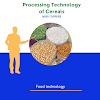Method of Storing the food
• Refrigerated: The food for which low temperature is essential or desirable such as fresh fruits, vegetables,dairy products and meat, have sharp metabolic reaction to external factor and requires refrigeration
• Non- Refrigerated: The other type of food products which have slower metabolic activity and resist to external factors are stored through this type of storage system.
Scientific storage structures
• Cold storage - Refrigeration, Chilling and
Freezing
• Jacketed storages
• Solar driven cold stores
• Controlled Atmosphere Storage (CA Storage)
• Modified Atmosphere Storage (MA Storage)
1. Cold storage
Controlling temperature is one of the main tools for extending postharvest life: low temperatures slows product metabolism and the activity of microorganisms responsible for quality deterioration Chilling or cold storage usually uses a slightly lower temperature on the basis of the food to be refrigerated In freezing a temperature of -18°C or below is used Chilling will preserve perishable foods for days or weeks and freezing will preserve foods for months or even years
2. Jacketed storages
These are double walled storages where heat conducted through the floor, walls and ceiling is intercepted and removed by the refrigeration system before it reaches the storage space. The walls, ceiling and floor act as cooling surfaces. Humidity close to 100% is maintained.
3. Solar driven cold stores
In tropical countries, solar energy is utilized in refrigeration cycle. In Sudan, such stores have been developed with 13 kw peak cooling power and were designed to keep 10 tonnes o fagricultural products (volume 50 m2) at a minimum temperature of 5°C.This system is however costly when compared to conventional cold stores operated by electricity.
4. Control Atmospheric Storage
•CA storage has been referred to as one of the most important innovation in fruits and vegetable storage.
•In conjunction with low temperature and high relative humidity this method implies the alteration of the gaseous environment inside the storage chamber.
•Oxygen concentration is lowered to about 2 to 3% and co2 is increased to 5%.
•Advantage :
Lowered respiration rate
Suppressed ethylene production rate
Reduced fruit sensitivity to ethylene
Improved texture
5. Modified Atmosphere Storage
• Modified atmosphere is the practice of modifying the composition of the internal atmosphere of a package/storage (commonly food packages, drugs, etc.) in order to improve the shelf life.
• The modification process often tries to lower the amountof oxygen (O2), moving it from 20.9 % to 0%, in order to slow down the growth of aerobic organisms and the speed of oxidation reactions.
6. DAMAGES DURING STORAGE
• Insect/ pests form one of the most important factors responsible for losses in agricultural production at various stages. Living organisms and the environment interact to bring about spoilage of stored products
• The damages can be grouped into, (1) direct dmages, and (2) indirect damages.
1. Direct damages
a. Few insects consume germ as well as some
endosperm and the others eat away both. It
causes in loss of weight, loss of nutrients, loss of germination power, loss in gradation and consequently falls in market value.
b. The contamination may be with the dead
bodies, excreta, cast skin, odour
c. Structures and containers also get damaged by causing tunneling in wooden parts
2. Indirect damages
a. It occurs when heat is created and migration of moisture takes place.
b. It creates distribution of parasites to man.
Few tape worms select stored grain insects as intermediate hosts.
Causes of spoilage during Storage
1. Temperature:
The higher the temperature the shorter the storage life of horticultural products and the greater the amount of loss within a given time.This means that the rate of growth of spoilage micro-organisms, the rate of indigenous physiological change and physical processes such as water loss and wilting are affected.
2. Humidity
• There is movement of water vapour between food and its surrounding atmosphere in the direction towards equilibrium water activity in the food and the atmosphere, a moist food will give up moisture to the air while a dry food will absorb moisture from the air.
• Dried or dehydrated products need to be stored under conditions of low relative humidity in order to avoid absorbing moisture to the point where mold growth occurs.
3. Biological pressure
Bacteria and fungi are always present in the atmosphere to contaminate food and cause spoilage and /conditions favour their growth.However, it should be emphasized that the contamination or inoculation process with bacteria and fungi occurs to an equal extent during the harvesting process.















0 Comments
Send feedback